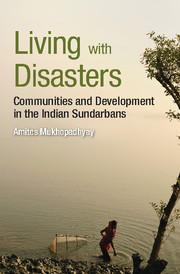Book contents
- Frontmatter
- Dedication
- Contents
- Maps and Illustrations
- Tables and Charts
- Glossary
- Acronyms
- Acknowledgements
- Note on Transliteration
- Maps
- Illustrations
- Charts
- 1 Introduction
- 2 From Wasteland to Wonderland: The Making of a Heritage Site
- 3 Governing the Sundarbans Embankments Today: Between Policies and Practices
- 4 Treading a Fine Path between River and Land: Livelihoods around Embankment
- 5 Beldars, Embankment and Governance: Question of Aboriginality Revisited
- 6 Catching Prawn, Endangering Embankments: Sustainability-Unsustainability Rhetoric
- 7 Conclusion
- Bibliography
- Index
2 - From Wasteland to Wonderland: The Making of a Heritage Site
Published online by Cambridge University Press: 05 March 2016
- Frontmatter
- Dedication
- Contents
- Maps and Illustrations
- Tables and Charts
- Glossary
- Acronyms
- Acknowledgements
- Note on Transliteration
- Maps
- Illustrations
- Charts
- 1 Introduction
- 2 From Wasteland to Wonderland: The Making of a Heritage Site
- 3 Governing the Sundarbans Embankments Today: Between Policies and Practices
- 4 Treading a Fine Path between River and Land: Livelihoods around Embankment
- 5 Beldars, Embankment and Governance: Question of Aboriginality Revisited
- 6 Catching Prawn, Endangering Embankments: Sustainability-Unsustainability Rhetoric
- 7 Conclusion
- Bibliography
- Index
Summary
Whose heritage site?
The first chapter has already introduced the Sundarbans as a World Heritage Site and described the life of its people as one of perpetual anxiety and uncertainty. What is it that makes people's lives so agonizing and uncertain in a place that is globally famous? The answer partly lies in the question posed. The Sundarbans is the abode of tigers, deer, snakes, crocodiles, dolphins, turtles and innumerable valuable plants and marine resources, whose protection and conservation has attracted considerable global funding in recent years. Such a conservation drive is based on the implicit assumption that the sustainable development of the Sundarbans is possible only if the natural habitat of the region is left to grow without hindrance. In other words, people's settlement and pressure on the unique ecological system is a cause for concern among the conservationists. It is to this representation of the Sundarbans as primarily a place of natural wilderness where humans occupy a position of secondary importance that I turn to in this chapter.
However, this image of the Sundarbans as natural wilderness not quite suitable for human settlement is not a natural fact since time immemorial. The biography of the region has been shaped and reshaped by colonial statemaking (Sivaramakrishnan 1999) involving complex negotiations at various local and trans-local levels. Sivaramakrishnan develops the idea of statemaking and employs it in understanding the emergence and institutionalization of modern forestry in colonial India. I draw on this concept to suggest that colonial statemaking in the Sundarbans proceeded through different phases and each phase produced a particular image of the region. This chapter embarks upon a historical journey revisiting the early period of colonial rule when the Sundarbans emerged as a wasteland over which conflict occurred between the landlords and the colonial state. This chapter goes back to the time when reclamation and human settlement in the Sundarbans was considered an urgent necessity by colonial rule. The chapter also looks at the post-reclamation history of the delta when the formulation of Forest Act and the modalities of gazetteer writing began to portray the region differently. What I attempt here in this chapter is not a chronological history. Instead, I will touch on four significant moments, both in colonial Sundarbans and in post-independent Indian Sundarbans, which played a crucial role in consolidating the image of the region as an abode of wildlife, …
- Type
- Chapter
- Information
- Living with DisastersCommunities and Development in the Indian Sundarbans, pp. 25 - 45Publisher: Cambridge University PressPrint publication year: 2016

